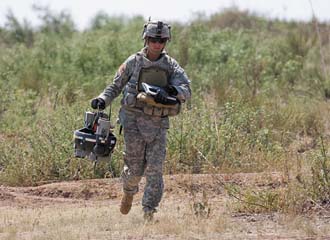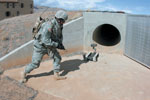One for the Money, Two for the Foe
 |
Part of the U.S. Army’s Increment 1 Tactical Network is the Class I unmanned aerial vehicle (UAV), which can fly into places other UAVs cannot and hover to collect intelligence about activity in a specific location over time. |
A seemingly dead program now has new life as the basis of a U.S. Army tactical communications system. Building on extensive past funding, the service is excerpting pieces of the past and crafting them into a network for the future. This time around, the Army is drawing the users into the design process sooner so that the results are likely to pay big dividends.
Although a collective gasp was audible nearly around the world when Defense Secretary Robert Gates announced plans to significantly restructure the Army’s Future Combat Systems (FCS), the decision was not a total surprise to most. Designed a decade earlier, the program was showing unexpected signs of aging: new vehicle designs were too inadequate to protect troops from adversaries’ improvised explosive devices, and advances in technology were leaving the humongous project behind the technical times.
The Increment 1 Tactical Network is a project that can only be described as a phoenix rising from the proverbial ashes. While the FCS focused on outfitting heavy brigade combat teams (HBCT), the resurrected program focuses instead on early infantry brigade combat teams (EIBCT). According to Col. Ken Carrick,
As the project manager for network systems integration at the Program Executive Office–Integration, Col. Carrick oversees six product managers that comprise the focus areas of the Increment 1 Tactical Network. Product managers are in place for: software integration of the System of Systems Common Operating Environment (SOSCOE); network systems, which includes the Army’s segment of the Joint Tactical Radio System (JTRS); battle command software, which includes applications that will run on the SOSCOE; the common controller for unmanned vehicles; joint and coalition interoperability; and intelligence, surveillance and reconnaissance integration, which ensures that sensor data pours into the network as one integrated common operational picture.
“My main point is that the [FCS] systems were built with enough flexibility to undergo that drastic a change. The spinouts from FCS have morphed over time and will continue to be the ‘good stuff’ that we are working on now for the warfighter,” Col. Carrick states.
Transitioning the work from the HBCTs to the EIBCTs demonstrates a significant focal change for the Army. Previously, brigade combat teams (BCTs) were viewed as a way to form revolutionary soldier combat units. Now, the focus is not on the future BCT but rather on putting all these capabilities into all brigades across the Army, Col. Carrick explains. Although this means that the standard BCTs will not be as robust as previously envisioned, they will have more depth, he adds.
This change represents a striking difference and true transformation of methodology the Army is employing to develop the systems, the colonel points out. Rather than creating a list of requirements or developing individual capabilities that may or may not help warfighters, the service is drawing users into the design process. After examining a capability, soldiers provide feedback to project managers and contractors. Changes then are incorporated into the next version of the technology, which is put through the user-review process again.
For example, the initial concentration of technology development involves sensors that can be tied into the network so that soldiers can tap into information before they walk into harm’s way. This simple communication processing change has enormous implications. In the past, information was gathered at ground level so that it could be passed up the chain of command to military leaders. Now, with the support of Army Vice Chief of Staff Gen. Peter W. Chiarelli,
 |
Unmanned ground vehicles are among the technologies that members of early infantry brigade combat teams likely will use to secure and collect information about an area. |
At this point in the process, which is phase three, the AETF is ensuring interoperability among existing systems. During phase four, scheduled for next year, the test process will continue the analyze-fix methodology as well as the initial operational test and evaluation, or IOT&E, of new technologies. The goal is to ensure interoperability within the Army with the exception of a ground soldier system, which cannot be achieved until the JTRS, a key enabler, is widely in use. Col. Carrick will not wager a guess as to when this total interoperability will occur, and in fact, interoperability was not a requirement for these technologies, he allows.
The next step after making Army systems interoperable with each other will be making them interoperable with the other
The colonel allows that Multinational Exercise 4 occurred in July at the “four eyes” level, with collaboration among the
One of the most challenging problems about fighting in
While brigade commander of the 5th Brigade, 1st Armored Division, AETF,
“Every time I go out to the field, I have a ‘wow moment,’ because every time soldiers look at new equipment, they show new and innovative ways to use it. These may not be the ways we envisioned the equipment being used, but in one way or another they improve on what we’ve given them to evaluate,” Col. Lane states. The colonel recently moved on from his position at the AETF to become the chief of staff, Headquarters,
The individual pieces of the systems being created were designed as part of the FCS network. Because the individual soldier remains the centerpiece of the work, the more the Army can get into the network, the more it will see the exponential benefits. “I call this the ‘goodness for the soldier.’ Integrating more capabilities into the network raises the ability to do things like get the COP [common operational picture] to the leaders so they can make decisions much faster. To me, that’s a victory,”
Integrating the information gathered by sensors is an example of the AETF’s focus areas. Eventually this capability will help protect troops who staff military gates and entryways. Using an unmanned ground vehicle, the guard could inspect a vehicle and its occupants from a distance. Using a microphone and speaker system, the operator will be able to tell the occupants to exit the car; using a video camera, the guards will be able to observe behavior and facial expressions that could tip them off to untoward activity.
Two examples of technologies that show promise but still need further development and improvements are the tactical unattended ground sensor and the urban unattended ground sensor. About the former,
In terms of the urban unattended ground sensor, the initial equipment design was too large overall and even the size of the camera did not represent the most current miniaturization available. In addition, while the cameras could distinguish that an object was a human being, they could not determine if the person was holding a weapon or was a high-value target; the lack of picture quality also eliminated the use of facial recognition technology. As a result of AETF input, the sensor is now approximately the size of the first iPod, and the video camera capabilities have been improved. The colonel allows that this sensor will continue to be tested and evaluated.
With its focus primarily on developing communications technologies that deliver information not only to military leaders but also to troops at lower echelons, the Army currently is developing the tactics, techniques, procedures, processes and doctrine necessary to field these solutions. Col. Carrick is one of many who recognize that the Increment 1 Tactical Network represents more than just fielding new equipment. “This is a shift in how the Army does battle command,” he states.
The colonel explains the challenges the Army faces as it transitions from the plans for FCS to the current solutions. Two problems in particular stand out in his mind: reliability and failure reporting. The reliability issue is being addressed through the test-fix-test development process. Determining the best way to uncover why a system has failed when 100 percent of the problems have been corrected is a tougher problem to solve, he admits.
It is in these areas that Congress and the Office of the Secretary of Defense evaluations lead to questions about the way the Army has handled technology developments. Col. Carrick emphatically emphasizes that everyone working on what could be called the remnants of the FCS has the best interest of warfighters at heart, and their single-minded goal is to produce systems that work. “We are not fielding equipment just to field equipment. Our ultimate goal is to make the warfighter more capable,” Col. Carrick states.
WEB RESOURCE
Army Brigade Combat Team Modernization: www.bctmod.army.mil




Comments